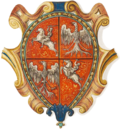| Herburt | |
|---|---|
 | |
| Details | |
| Battle cry | Herburt |
| Alternative names | Pawcz, Fullstein, Herbort, Herbortowa, Voronich |
| Earliest mention | Westphalia, Moravia, Poland (1353) |
| Towns | Bohušov (Cz), Felsztyn(PL -1939) |
| Families | Arłamowski, Chełmowski, Dobromilski, Falsztyn, Fulstein, Fulsztyn, Fulsztyński, Gerberski, Hajbowicz, Helman, Herberski, Herbortowski, Herburt, Hewel, Hewell, Heybowicz, Katyna, Kobyliński, Kozika, Kozieka, Kozieł, Koziełł, Lewgowd, Milatowskic, Mierzewski, Modzelewski, Modzelowski, Nicz, Nosicki, Nowicki, Odnowski, Ponyrko, Powęzowski, Rymgayło, Rymgayłowicz, Wismułowicz, Wisnarzewski, Woronicz, Zyniew |
Herburt is a Polish coat of arms. It was used by several distinct and unrelated szlachta families such as the Pawcz family of Ruthenian Galicia. A coat of arms is an individual or family heirloom the origins of which lie in the 12th century. [1]
Contents
English Wikisource has original text related to this article:






